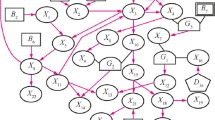Abstract
Developed from the dynamic causality diagram (DCD) model, a new approach for knowledge representation and reasoning named as dynamic uncertain causality graph (DUCG) is presented, which focuses on the compact representation of complex uncertain causalities and efficient probabilistic inference. It is pointed out that the existing models of compact representation and inference in Bayesian Network (BN) is applicable in single-valued cases, but may not be suitable to be applied in multi-valued cases. DUCG overcomes this problem and beyond. The main features of DUCG are: 1) compactly and graphically representing complex conditional probability distributions (CPDs), regardless of whether the cases are single-valued or multi-valued; 2) able to perform exact reasoning in the case of the incomplete knowledge representation; 3) simplifying the graphical knowledge base conditional on observations before other calculations, so that the scale and complexity of problem can be reduced exponentially; 4) the efficient two-step inference algorithm consisting of (a) logic operation to find all possible hypotheses in concern for given observations and (b) the probability calculation for these hypotheses; and 5) much less relying on the parameter accuracy. An alarm system example is provided to illustrate the DUCG methodology.
Similar content being viewed by others
References
Shortliffe E H, Buchanan B G. A model of inexact reason in medicine. Mathematical Bioscience, 1975, 23(3/4): 351–379.
Shafer G. A Mathematical Theory of Evidence. Princeton, NJ: Princeton University Press, 1976.
Duda R O et al. Development of the Prospector consultation system for mineral exploration. Final report, SRI Project 5821 and 6415, SRI International, 1978.
Zadeh L A. The role of fuzzy logic in the management of uncertainty in expert systems. Fuzzy Sets and Systems, 1983, 11: 199–227.
Pearl J. Fusion, propagation, and structuring in belief networks. Artificial Intelligence, 1986, 29(3): 241–288.
Pearl J. Probabilistic Reasoning in Intelligent Systems. San Mateo: Morgan Kaufmann, 1988. ISBN 0-934613-73-7.
Henrion M. Practical issues in constructing a Bayes’ belief network. In Proc. the 3 rd Conf. Uncertainty in Artificial Intelligence, July 1987, pp.132–139.
Srinivas S. A generalization of the noisy-OR model. In Proc. the 9th Conf. Uncertainty in Artificial Intelligence, San Francisco, July 1993, pp.208–215.
Diez F J. Parameter adjustment in Bayes networks: The generalized noisy-OR gate. In Proc. the 9th Conf. Uncertainty in Artificial Intelligence, 1993, pp.99–105.
Pradhan M, Provan G, Middleton B, Henrion M. Knowledge engineering for large belief networks. In Proc. the 10th Conference on Uncertainty in Artificial Intelligence, July 1994, pp.484–490.
Gilio A, Scozzafava R. Conditional events in probability assessment and revision. IEEE Trans. Systems, Man and Cybernetics, 1994, 24(12): 1741–1746.
Zhang N L, Poole D. A simple approach to Bayesian Network computation. In Proc. the 10th Biennial Canadian Artificial Intelligence Conference, 1994, pp.171–178.
D’Ambrosio B. Local expression languages for probabilistic dependence. Int. J. Approximate Reasoning, 1995, 13(1): 61–68.
Boutilier C, Friedman N, Goldszmidt M, Koller D. Context-specific independence in Bayesian network. In Proc. the 12th Conf. Uncertainty in Artificial Intelligence, Aug. 1996, pp.115–123.
Heckerman D, Breese J S. Causal independence for probability assessment and inference using Bayesian networks. IEEE Trans. Systems, Man and Cybernetics, 1996, 26(6): 826–831.
Cowell R G, Dawid A P, Lauritzen S L, Spiegelhalter D J. Probabilistic Networks and Expert Systems. New York: Springer, 1999.
Takikawa M, D’Ambrosio B. Multiplicative factorization of noisy-MAX. In Proc. the 15th Conf. Uncertainty in Artificial Intelligence, July 30-Aug. 1, 1999, pp.622–630.
Jensen F V. Bayesian graphical models. In Encyclopedia of Environmetrics, Sussex: Wiley, 2000.
Pfeffer A. Sufficiency, separability and temporal probabilistic models. In Proc. the 17th Conf. Uncertainty in Artificial Intelligence, Aug. 2001, pp.421–428.
Russell S J, Norvig P. Artificial Intelligence: A Modern Approach, 2nd edition. Prentice Hall, 2003.
Pearl J, Russell S. Bayesian networks. In The Handbook of Brain Theory and Neural Networks, 2nd edition, Arbib M A (ed.), MIT Press, 2003.
Poole D, Zhang N L. Exploiting contextual independence in probabilistic inference. Journal of Artificial Intelligence Research, 2003, 18(1): 263–313.
Zagorecki A, Druzdzel M. An empirical study of probability elicitation under noisy-OR assumption. In Proc. the 17th FLAIRS, May 2004, pp.880–885.
Schubert L K. A new characterization of probabilities in Bayesian networks. In Proc. the 20th Conf. Uncertainty in Artificial Intelligence, Banff, Canada, July 7–11, 2004, pp.495–503.
Lucas P J F. Bayesian network modeling through qualitative patterns. Artificial Intelligence, 2005, 163(2): 233–263.
Chavira M, Allen D, Darwiche A. Exploiting evidence in probabilistic inference. In Proc. the 21st Conf. Uncertainty in Artificial Intelligence, July 2005, pp.112–119.
Milch B, Marthi B, Sontag D, Russell S, Ong D L, Kolobov. Approximate inference for infinite contingent Bayesian networks. In Proc. the 10th International Workshop on Artificial Intelligence and Statistics, Barbados, Jan. 2005.
Zagorecki A, Voortman M, Druzdzel M J. Decomposing local probability distributions in Bayesian networks for improved inference and parameter learning. In Proc. the 19th FLAIRS Conference, Melbourne Beach, USA, May 2006, pp.860–865.
van Gerven M A J, Lucas P J F, van der Weide Th P. A generic qualitative characterization of independence of causal influence. International Journal of Approximate Reasoning, 2008, 48(1): 214–236.
Li W, Poupart P, van Beek P. Exploiting causal independence using weighted model counting. In Proc. the 23 rd AAAI Conference on Artificial Intelligence, Chicago, USA, July 13–17, 2008, pp.337–343.
Zhang Q. Probabilistic reasoning based on dynamic causality trees/diagrams. Reliability Engineering and System Safety, 1994, 46(3): 209–220.
Author information
Authors and Affiliations
Corresponding author
Additional information
This work is supported by Guangdong Nuclear Power Group of China under Contract No. CNPRI-ST10P005 and the National Natural Science Foundation of China under Grant No. 60643006.
Electronic Supplementary Material
Below is the link to the electronic supplementary material.
Rights and permissions
About this article
Cite this article
Zhang, Q. Dynamic Uncertain Causality Graph for Knowledge Representation and Reasoning: Discrete DAG Cases. J. Comput. Sci. Technol. 27, 1–23 (2012). https://doi.org/10.1007/s11390-012-1202-7
Received:
Revised:
Published:
Issue Date:
DOI: https://doi.org/10.1007/s11390-012-1202-7




